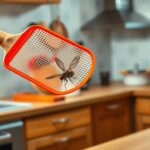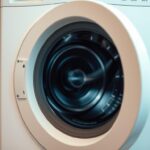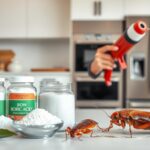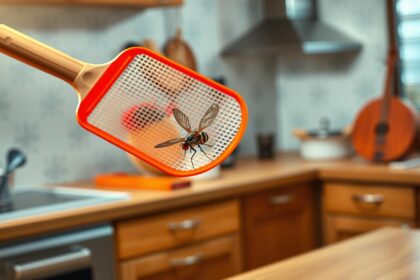Are unwanted mice scurrying around your home, making you feel uneasy and frustrated? You’re not alone. Many homeowners struggle with mouse infestations, but there are effective methods to eliminate them. It’s time to take back your home and enjoy a peaceful living space.
Mouse infestations can be a significant problem, but with the right strategies, you can get rid of them for good. In this article, we’ll explore proven DIY mouse removal techniques and mouse extermination methods to help you tackle the issue confidently.
Key Takeaways
- Identify signs of mouse infestation early
- Seal all entry points to prevent re-infestation
- Use effective DIY mouse removal techniques
- Implement mouse extermination methods for severe infestations
- Maintain a mouse-free home with regular checks
Understanding the Mouse Problem
It’s important to know the signs of mice to tackle the issue. Look out for signs that mice are in your home.
Signs of Mouse Infestation
Mice leave clues like visual signs and sounds. These help you spot their presence.
Visual Evidence: Droppings and Damage
Mice droppings are a clear sign. You might also see gnaw marks on furniture or walls. Look for shredded paper or fabric as nesting materials.
Auditory Clues: Scratching and Movement
At night, mice can be heard scratching or moving in walls. Listen for these sounds to find out if they’re there.
Health Risks Associated with Mice
Mice can contaminate food and spread diseases. They carry viruses and bacteria in their droppings, urine, or saliva. This poses health risks to you and your family.
Common Entry Points for Mice
Mice sneak in through tiny openings. It’s key to seal all entry points. Check for holes around pipes, vents, and doors. Use steel wool or caulk to seal them.
| Common Entry Points | Sealing Methods |
|---|---|
| Holes around pipes | Steel wool or caulk |
| Gaps under doors | Weatherstripping or door sweeps |
| Vent openings | Hardware cloth or metal mesh |
How to Get Rid of Mice: Initial Assessment
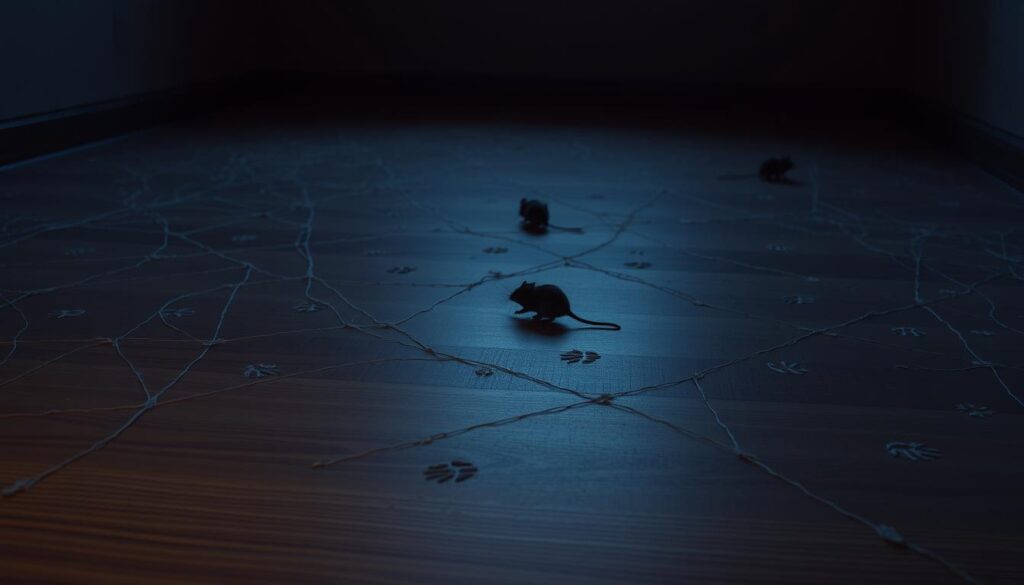
Knowing the extent of your mouse problem is key to solving it. First, you must carefully assess the situation.
Determining the Severity of Infestation
Look for signs of mice like droppings, gnaw marks, and nests. The more signs, the worse the problem.
Identifying Mouse Travel Routes
Mice often follow the same paths, like along walls and behind appliances. Knowing these paths helps you set traps better.
Creating an Elimination Strategy
After assessing, you can make a plan to get rid of the mice. This plan should cover both immediate and long-term steps.
Short-term vs. Long-term Approaches
Short-term plans might include traps or repellents to quickly lower mouse numbers. Long-term plans involve sealing holes and making your home less mouse-friendly.
Budgeting for Mouse Control
It’s important to plan your budget for mouse control. Some methods, like traps and repellents, can cost money. Also, sealing holes might need an investment.
| Method | Cost | Effectiveness |
|---|---|---|
| Snap Traps | $5-$10 | High |
| Humane Traps | $20-$50 | Medium |
| Sealing Entry Points | $10-$50 | High |
By understanding the problem, finding mouse paths, and making a detailed plan, you can effectively remove mice from your home.
“The key to successful mouse elimination lies in accurately assessing the situation and developing a tailored plan.”
Sealing Entry Points: The First Line of Defense
To keep mice out of your home, start by sealing entry points. This is a key part of any DIY mouse removal technique. It stops new mice from coming in and makes it simpler to get rid of the ones already there.
Materials Needed for Sealing
To seal entry points well, you’ll need a few things. These include:
- Steel wool: Mice don’t like to chew through steel wool, making it an effective barrier.
- Caulk: Use caulk to seal small cracks and holes, around windows and doors.
- Expanding foam: This is great for bigger gaps, like those around pipes and vents.
Step-by-Step Sealing Process
Sealing Small Cracks and Holes
First, check your home’s foundation, walls, and roof for small cracks or holes. Use caulk or steel wool to block these openings. Focus on areas around utility pipes and vents.
Addressing Larger Openings
For bigger gaps, expanding foam works well. Always wear gloves and follow the instructions when using expanding foam.
Addressing Hard-to-Reach Areas
Sealing spots like attic spaces or behind appliances can be tough. Use a flashlight to inspect these areas well. A mix of steel wool and expanding foam can help block mouse entry points in these hard spots.
By sealing all entry points well, you’re taking a big step towards getting rid of mice. This not only helps get rid of the current problem but also stops future ones. It makes your home safer and healthier.
Traditional Mouse Trapping Methods
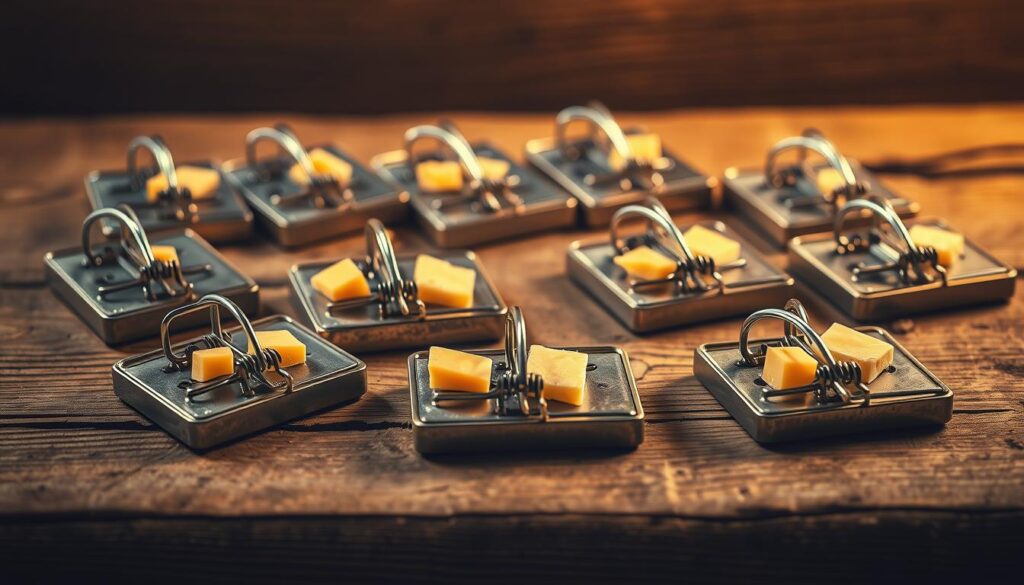
Homeowners have many ways to get rid of mice. These methods have been around for a long time. They work well if used right.
Snap Traps: Placement and Baiting
Snap traps are very common and effective. To use them well, you need to know how to set them up and bait them.
Snap Traps: Placement and Baiting
The bait you use can make a big difference. Here are some of the best baits:
- Peanut butter
- Cheese
- Nuts
- Dried fruit
Strategic Placement Techniques
Where you put the traps is key. Place them where you see mouse signs, like droppings or gnaw marks. Good spots include walls, behind appliances, and dark corners.
Glue Traps: Pros and Cons
Glue traps catch mice by sticking them to a surface. They’re cheap and easy to use. But, they can be cruel and catch animals not meant to be trapped.
Live Traps: Humane Mouse Removal
Live traps are a kinder option. They catch mice alive, so you can release them far from your home.
Handling Captured Mice
When you catch a mouse, wear gloves to avoid disease. Handle the trap gently to not stress the mouse too much.
Relocation Considerations
Think carefully about where to release a caught mouse. It should be far enough away but also good for the mouse. Always check local laws about releasing wildlife.
Safety Considerations When Using Traps
Always put safety first when trapping mice. Here are some tips:
| Trap Type | Safety Consideration |
|---|---|
| Snap Traps | Place out of reach of children and pets to avoid accidents. |
| Glue Traps | Be cautious of non-target catches, and consider the humane implications. |
| Live Traps | Handle with care, and release mice in a suitable location. |
Choosing the right trap and using it correctly can help control mice at home. Always think about safety and being kind to mice.
Chemical Solutions and Rodenticides
Chemical solutions and rodenticides are strong tools against mice. But, they must be handled with care. Used right, they can clear your home of mice.
Types of Mouse Poisons
There are many mouse poisons out there. Anticoagulant rodenticides cause mice to bleed inside. Non-anticoagulant rodenticides can fail mice in other ways. Anticoagulant poisons are the most used and come in pellets, blocks, and liquids.
Safe Application Methods
To safely use mouse poisons, do the following:
- Always follow the instructions from the maker.
- Put bait in spots mice like but keep it away from pets and kids.
- Use bait stations to keep the poison safe and prevent accidents.
Risks to Pets and Children
Chemical rodenticides can harm pets and kids if mishandled. Accidental ingestion can cause serious health problems. It’s important to take steps to avoid these dangers.
Safety Precautions
To stay safe, always:
- Wear gloves when you handle rodenticides.
- Keep the poison in its original packaging.
- Dispose of dead mice and unused bait as the maker says.
Alternative Options for Homes with Pets
If you have pets, think about using natural mouse deterrents or humane traps. These options are safer for your pets and can work well.
Disposal of Poisoned Mice
It’s key to dispose of poisoned mice right to avoid harming pets and wildlife. Wear gloves and put the dead mice in sealed bags. Then, throw them away in the trash.
Natural and DIY Mouse Deterrents

Looking into natural and DIY mouse deterrents offers many options to keep your home mouse-free. If you prefer not to use chemicals, there are several natural ways to keep mice away.
Essential Oils as Repellents
Certain essential oils can repel mice because of their strong smells. Peppermint oil is one of the most effective.
Peppermint Oil Applications
Peppermint oil can be used in different ways to keep mice away. Here are a few methods:
- Soak cotton balls in peppermint oil and place them where mice are seen.
- Mix peppermint oil with water and spray it around entry points.
- Use a diffuser to spread the scent throughout your home.
Other Effective Essential Oils
Other essential oils that can repel mice include:
- Lavender oil
- Eucalyptus oil
- Tea tree oil
These oils can be used like peppermint oil to keep mice away from your home.
Household Items That Repel Mice
Some common household items can also keep mice away. These include:
| Item | How it Repels Mice |
|---|---|
| Mothballs | Strong smell deters mice |
| Steel wool | Mice don’t like to chew through it |
| Ultrasonic devices | Emit sounds undesirable to mice |
Homemade Mouse Repellent Recipes
You can make your own mouse repellents using household items and essential oils. For example, mixing peppermint oil with water and vinegar makes a good spray.
Effectiveness of Natural Methods
Natural methods can be effective, but their success depends on the infestation’s severity. It’s important to be patient and might need to use more than one method.
Combining Natural Methods for Better Results
For better results, try combining different natural deterrents. For example, using peppermint oil and sealing entry points with steel wool can help keep mice away.
Exploring these natural and DIY mouse deterrents can help you find a solution that works for you and your home. Remember, being persistent and using a mix of methods often gives the best results.
Cleaning and Sanitizing After Mouse Elimination
After getting rid of mice, it’s important to clean and sanitize your home. This step helps remove any mouse signs and stops future problems. You’ve already taken the first step by getting rid of the mice. Now, it’s time to clean up.
Safe Cleanup of Mouse Droppings
When cleaning mouse droppings, safety is key. Wear gloves and a mask to protect yourself. Use a disinfectant to clean the area well. Don’t sweep or vacuum droppings, as it can spread particles in the air.
Disinfecting Contaminated Areas
Disinfect all areas where mice were seen, like countertops and floors. Use a mix of bleach and water to kill germs. Always follow the instructions on the bleach bottle for the right mix.
Disposing of Nesting Materials
Get rid of any nesting materials, like insulation, in sealed bags. This stops mice from coming back. Wear gloves when touching these materials to avoid getting sick.
Addressing Lingering Odors
To get rid of bad smells, use an odor eliminator or baking soda. Open windows and use fans to help air out the area. For strong smells, you might need a stronger odor eliminator.
By following these steps, you can make sure your home is clean and safe after getting rid of mice. This reduces the chance of mice coming back and makes your home healthier.
Professional Mouse Control Services
Dealing with mice at home can be tough. Sometimes, you need the help of mouse control experts. They have the skills to get rid of mice for good.
When to Call Professionals
If DIY methods don’t work, it’s time to call the pros. A big mouse problem is another sign. Look out for:
- Seeing mice every day
- Damage to your stuff
- Mice in different parts of your house
What to Expect from Extermination Services
Experts start by checking your home for mouse entry points. They’ll find out how bad the problem is. Then, they’ll make a plan to keep mice away for good.
Cost Considerations
The price for mouse control services depends on the problem size and your home’s size. Expect to pay between $200 and $500 for a full service.
Selecting a Reputable Service Provider
Choose a service that removes mice humanely and has good reviews. Ask these questions before you decide:
Questions to Ask Before Hiring
- What methods do you use for mouse removal?
- Do you offer any guarantees?
- Can you provide references?
Evaluating Service Guarantees
A good service should promise to come back if mice come back. Make sure you understand the guarantee before you hire them.
Preventing Future Mouse Infestations
To stop mice from taking over, you need to keep your home in good shape and use smart ways to keep them away. By being proactive, you can greatly lower the chance of mice moving into your home.
Home Maintenance Practices
Keeping your home well-maintained is key to avoiding mouse problems. Regular checks for mouse signs and seasonal upkeep can help keep your home mouse-free.
Regular Inspection Routines
Make it a routine to look for mouse signs like droppings and gnaw marks. Also, check for gaps or holes, mainly where utilities come in.
Seasonal Maintenance Tasks
Tasks like cleaning gutters and checking roof tiles can stop mice from getting in. Also, keep your yard tidy to discourage mice from nesting nearby.
Food Storage Solutions
Storing food right is a great way to keep mice away. Use containers that mice can’t get into for grains and pet food. Always clean up after meals and don’t leave food out.
Yard and Garden Management
It’s important to manage your yard and garden too. Keep your grass short, remove weeds, and trim back trees and shrubs near your home. This makes it harder for mice to get to your house.
Long-term Deterrent Methods
For lasting protection, use mouse-resistant materials when building or fixing up your home. Also, keep using repellents and sealing entry points to keep mice out.
Mouse-Resistant Construction Materials
Materials like steel wool and caulk can seal gaps and protect your home from mice.
Ongoing Prevention Strategies
Always check for new entry points and keep using deterrents like peppermint oil. Also, use ultrasonic devices to keep mice away.
| Prevention Method | Effectiveness | Ease of Implementation |
|---|---|---|
| Sealing Entry Points | High | Medium |
| Proper Food Storage | High | Easy |
| Yard Maintenance | Medium | Easy |
| Using Repellents | Medium | Easy |
Conclusion
You’ve started the journey to a mouse-free home by spotting signs of infestation and acting. You’ve learned to seal entry points, use traps, and consider chemicals. Now, keeping your home clean is key to stopping mice from coming back.
Using good mouse prevention methods is important. This includes keeping your home in good shape, storing food right, and managing your yard. Natural repellents like essential oils can also help. If mice are a big problem, get help from experts in mouse control.
With these methods, you can solve your mouse problem and live in a safer space. Stay alert and proactive to stop mice from coming back. Using the right extermination and prevention strategies will help you keep your home healthy.



